Orbit
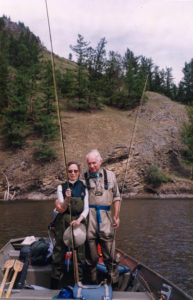
When I first took up fly fishing it was an enthusiastic love affair. I purchased hundreds of flies and multiple rods before actually catching much. And since my wife shared a half dozen other sports with me, I gifted her one of every type fly I owned. First times out our flies were catching quite a few treetops, so we carried four of each of a lot of patterns and sizes.
This occurred maybe our third outing: We were moving up a Beaverkill bankside, probably jingling from all our festooned gear. There was an old man, thin and wearing street clothes, he had a fish on. We waited as he gracefully released it with skill I had yet to learn. Being gauche I asked what the fish took.
And being courteous but moving away he replied, “Parachute Adams 14. It’s the only fly I carry.”
My wife, the old soul, watched him rounding a bend. She said, “He looked like us once. He’s orbited around to so simple.”
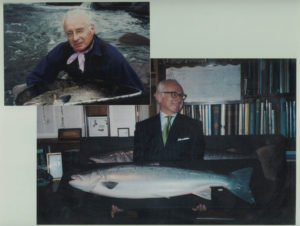
and photo of a catch in Russian Arctic Circle
That incident has stayed with me. When I brought Ruin alive I wanted to portray both sides of wonderful in fly fishing. The mysterious capacity for replete expertise. And too, at the other side of the moon of understanding, the mysterious capacity for reductive simplicity.
So it is in Ruin that there are the well read technically expert fishers of the Anamorphosis Flyfishing Club. Yet too, on that other side of the sport, there is Ruin’s Frank Campbell, the noble savage fishing instinctively in simplicity.
Stone Age Today
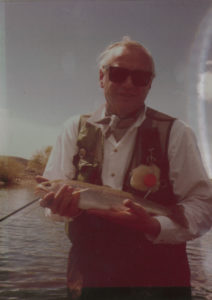
hooked this time
In Ruin Frank takes the man who bankrupted him fishing on a Guatemalan jungle river. But not fly fishing. By then in Part Three Frank has been traveling itinerantly in research for his book about unorthodox fishing techniques from the past. They are after “alligator fish,” gar. And for their bait first caught bottom-dwelling minnows with preposterously romantic names that perhaps lonely ichthyologists gave them. The fishers have great success, including Frank braving the fast river to swim to a giant gar who stole their rod, which he retrieves. Recall the pike in the Lake Erie drowned forest that stole Francy’s rod, irretrievably.
Like most of the fishing episodes in Ruin this is loosely based upon my own experiences. My wife and I were floating a black-dark Peten Jungle river and the rod did indeed go overboard. But it was our teen-age guide who jumped in and tried to recover it. Alas this was not fiction and he could not.
For his book Frank is rigged as a paleolithic Stone Age fisher with no hook or barb. It is a device he heard of from someone at the Anamorphosis Flyfishing Club.
Back to the reality behind Ruin: I saw this fishing method work in a remote reach of Eastern Bhutan. The simple reality was as good as fiction might make it. We were trekking with a local crew through a rhododendron forest on a Himalayan slope. At streamside lunch I set up my traveling fly rod for a try. The whole crew except the cook excitedly followed, since as Tantric Buddhists they were not allowed to fish. My gear was a mess from days of travel, and I am slow to rig under best conditions.
While I was fiddling, a very short thin man appeared on the opposite bank of our big pool, carrying a twenty-foot sapling from which hung a rope with a rock tied at its end. A foot up from the rock a six-inch loop was tied, at the joinder of which was a bright red berry or bead. My guys said, “Boss don’t talk. He’s bad.” What he looked like to me was an indigenous tribesman, so not a Buddhist. The guys said, “Boss hurry. Show him.” My technology aficionados.
But within the five minutes of my further fumbling the little cave man grunted and levered a gleaming bronze five-pound carp over his head. With never a look to us he bonked it dead and walked back over the ridge toward dinner.
“Boss!” My fans were close to tears. I put on a weighted black leech and cast relentlessly. Finally, success … another big carp. But it was foul-hooked behind its dorsal fin. I did not explain the sporting nicety.
The guys were suddenly ecstatic. We drove on in the top-down old Land Rover. And each time we passed someone, a member of the crew held up and waggled my trophy, singing loudly. I slumped down low in the passenger seat, realizing I actually was wearing a safari jacket (for the pockets, just for the pockets). Dinner was fish stew which the guys could eat because just some foreign devil had caught and killed it.
Write to See and Feel
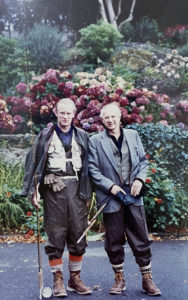
Ireland
For a decade my pal Barnaby Conrad III and I wrote and published The Royal Coachman, an eccentric fly fishing travel journal equally focused on good sport and good creature comforts. We turned a little profit every year, advertising in The New Yorker magazine.
But not such a profit that we could pay a writer and expenses. So we hired ourselves for free. I really should have been paying The Royal Coachman a nice fee for my experiences. Magically I found that going in search of good successful fishing followed by a good successful dinner with good successful wine made a new creature of me. I suddenly looked at everything involved with intensity. I wanted our readers to know where and what and when, and what not and when not. To deliver best advice I could give.
That was the benefit of our journal since it is so easy to go exploratory fishing and become miserable due to ignorance. I once flew with my long-suffering wife from her beloved Istanbul to the Turkish Black Sea coast to try two rivers favorably mentioned in an old English travel book, only to find them diverted down to trickles in which ladies were washing undies with very smelly soap and upstream was a barriered Army base.
This penetrating journalistic inquiry, a big step for an impressionistic fellow like me, changed how I fished. I went into bars and sought out local fishers, working them like a seeming casual but meticulously memorizing spy. I studied the topography, driving the extents of streams so I knew where what types of water lay. I got the season laws straight and how to get permits when needed. I switched hotels and restaurants to recommend the best, with contact information. I found where the fly shops and guides were.
Years ago Simon and Schuster hired me as The Royal Coachman to write the introduction to its primer on fly fishing. My basic message was what in Ruin Dr. Arbuthnot tells depressed Frank: Go, just go fishing. Don’t worry about how others do it, make the experiences your own uniquely.
But by the time of writing Ruin, I had the good doctor add even better advice. It draws upon what I learned from The Royal Coachman days. Go and really observe, then write it down straight to remember. Frank does evolve to being a fishing writer.
Truth and Consequences
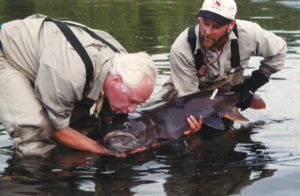
Ruin resulted from hearing a bankruptcy lawyer mention a heart-breaking case where he could not help a couple who lost everything in a large, litigious bankruptcy. And hearing how hard it was on the marriage since the wife was a naïve heiress who casually guaranteed a debt that exploded, and who had to then leave New York with her husband to live rurally. I later met the actual couple as then aging neighbors. From this origin, Ruin grew. Its process of composition was chemistry of diverse personality observations and diverse memories, mixed with an elixir of strong emotions from life and literary art the writer carried into the tale however they entered his spirit.
As to the various fishing episodes in this novel the same composition process developed. All but one is factually based on my actual experience. Yet they are neither simple reportage nor so distorted as to constitute pure fantasy. If one’s discrete scene memories are like photographs, then these episodes for me carried what the great Alfred Stieglitz termed equivalence. Basically meaning that objective content in an artful photo subtly can trigger somehow associated feeling and perception.
Ruin’s composition process as to fishing episodes actually was itself my equivalence experience. Here is a not so simple example. The very first time I stepped into a New Zealand river my guide had lined up five tiny nymphs on my chest. From a high bank we could see a preposterously big trout holding at middle of the flow. The guide said when you get down there you will not see that fish any more. He told me to cast a fly one time each in order from left end to right below the exposed triangular boulder top. Forty-foot cast, fly lands two feet below the rock and to its right side. If no take put the next fly on, and so forth, unless rhe guide whistles from the ridge because it spooked away.
That fish did not spook. When struck it swam downstream more powerfully than any trout I ever had on. In a flash its bolt had my reel screeching out backing line. I had to chase, churning through current down the deep center of the pool, since a chuting rapids lay ahead where it could easily snap off. I slipped and fell in but was wearing the New Zealand gear of tights, shorts, and light boots. So, holding the rod tip up, I dog paddled a bit to a big rock, climbed atop it, and was able to turn the tiring big one short. I was able to release a two-foot brown without ever lifting it out of the water. Competent respect of the prey being my own due role in high sport.
That of course became Ruin’s opening chapter vision of fly fishing at the chameleon bridge over the Rubicon River. Frank looks down and sees athletic Jace swimming to and with a big fish. Only after I had first written that much did I recall a scene in Norman MacLean’s A River Runs Through It. There the doomed competitive fisherman brother swims to a rock to reach where others cannot. That scene was an equivalence of the brother’s obsessive character. And so I rewrote to enhance Frank’s own retrospect of Jace’s moment. To realize in that instant he in foreboding could have foreseen Jace’s personality core that would become both his and Jace’s bane.
Carpology
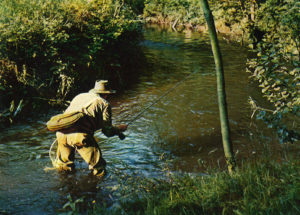
The only fully imagined fishing episode in Ruin is at the English carp lake. It is where Aldous Huxley’s stunningly mordant 1939 novel After Many a Summer Dies the Swan is partly set. The small lake has held long-lived carp since it was dug by monks in the Middle Ages.
I won’t give away the story here, but my research of modern carp fishing in Britain and Europe uncovered surprises as vivid as a far-fetched fantasy.
Carp fishing historically and now is a British male working-class sport. Its ethos and technicalities are at polar opposite of middle-class trout fly fishing. To my surprise I saw proper carp fishing in lakes involves a closed world of complexity comparable to the closed world of proper trout fly fishing in streams.
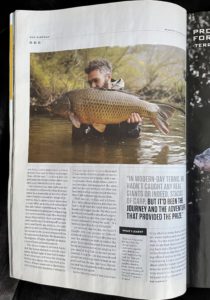
The photo here is the cover of one of multiple publications carp fishers contribute to and learn from, in addition to books. The man is kissing the fat fish before returning it to its water. Carp fishermen often do this. For the carp it can become an often-repeated experience. Distinctively marked individual fish acquire marquee names like movie stars: Old George, Raggedy Butt, so forth. They grow to sixty pounds as vegetarians, and can live as many years. They are in no danger of extinction since none is ever killed, young fish are stocked, and access to their lakes is controlled by paid permit limits.
Ruin’s depiction of the fisher’s gear is very accurate. While static as to their own movement once in place, the mental strategizing of expert carpers has long been both intense and rapidly evolving in content over past decades. For centuries carp (which are tasty) were caught on bread and potatoes sometimes concocted with honey and worms. But in the twenty-first century carp baiting has jumped to new technological complexity. For carp fishers this means modern chemistry offers a wealth of new bait compounds. And judging from the sport’s articulate literature, a wealth of opportunity for both experiment and dispute sometimes fueled by alcohol in lakeside vigils.
“Fish got a brain size of a pea,” Robert cautions Frank in Ruin. But among carp fishers respect for the subtle behavior of grazing fish, hypersensitive to smell yet highly unpredictable of response, makes them in effect highly intelligent adversaries worthy of respect. Thus magazines and books are filled with photos of men smooching bulbously overweight tough old carp of the dozen species.
I found this sport intriguigingly warm-hearted. After all trout fishers should not really touch their delicate catches at all much less smooch them.
Today over fifty businesses globally sell compounds and materials, often patented and jealously enforced, for use in baiting. There are fisher proponents and fisher opponents of dozens of permutations of bait material and carp mentality cultivation. One can argue for or against a preparatory bath of “bait” in illogical spicy chorizo sauce. Or in Britain preposterous pineapple juice. Or one of the dozens of commercial baths for one of the hundreds of commercial baits. One can argue over how far from the hook bait one should slingshot a “hospitality” of chum bait of the same nature, of the same or different size, spherical or chopped. Argue for a “pop up” keeping the hook bait an inch or so above the lake bottom, or for sinking the hook bait naturally among the arrayed hospitality.
The complexity is fascinating. But still there are those who choose sometime to revert to simplicity. In a contrarian strategy, they throw out a hooked parboiled potato with a clump of worms. They tend to be loners.
Ruin’s last passage is its people in their concluding moment. In writing I realized what I was portraying as to their carp adventure resonated Frank’s whole preceding quest to become a trout fisherman. That scene’s complicated technical carp pursuit balanced with Frank’s past as a noble savage simple trout fisherman: Frank through it all had found that there is deep good spirit in outdoor sport. And we readers through it all have seen that comparison of sophisticated complexity or instinctive simplicity is really detail. Not essence.
Art Aswim
Really looking at any trout is difficult.
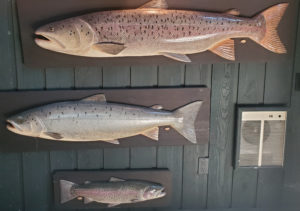
Atlantic Salmon and rainbow trout
From above to bird predators the always dark backs look like shadow lines in their streambed rock jumbles. To bankside observers, on four feet or on two feet, they disappear beneath flexing currents’ water top mirrors.
And even for some fly fishers, who have a trout brought to hand, the fish itself is gone before it can be studied. About eight percent of trout releases die from the catch experience. For many adepts, and here at least I am an adept, each of our magic trout caught deserves its best chance to be in the ninety-two percent. And so, as good science advises, we unhook them fast as possible still in the water. Our trout are gone faster than our vision.
Frank in his first time in Ruin out fishing has not evolved to this code of conduct. He naturally wants to study his 18-inch surprisingly toothed first brown trout. Mid-day helpfully turns up light intensity for him. The fish is regarded as if a painting on a museum wall. The sun-yellow belly and ventral fins with white edge. Up at the back solid dark brown with brown-dot gray dorsal fin. And then there is the explosion of colors on its slab side—vivid to Frank though that would be dim in a trout’s range of color distinction. Colors arrayed distinctly as computer coding taps, a spangle of ruby-centered white aureole dots float spaced all along the flank as it shades from yellow up to gray up to brown. Dark-centered dots merge up into the solid dark ground of the fish cylinder’s top.
Frank is properly in love at first sight. But he has no conception of what he holds in his hand. Because this one trout, like all of them around the globe, is an image tapped out by a code of unreachable complexity over constantly evolving time. Scientists, the ichthyologists and biologists, cannot reconstruct that code into satisfactory Linnean specie boxes. The range of variations within even one small geographic area is both too great and is constantly re-iterating. This is true especially in this last hundred years as globality mixes populations together. That engenders hybrids, which some of us try to forestall and some of us value for pragmatic reasons.
And then more complexity. With modern sampling it is revealed that individual trout sometimes try painting their own identity differing from their brethren swimming right beside them. Why? That would be what makes the world go around for fishers too … sex and fear of death.
So modern science largely has moved away from past centuries’ certainty of lineages of trout. It seems pointless to many. They consider the myriad of beautifully painted hyper-local variant expressions evolving sometimes rapidly over and over during and after multiple Ice Ages.
In Ruin Frank the noble savage fisherman, enjoined by his magus Dr. Arbuthnot to not read about fishing at all, won’t have time to learn trout taxonomy before life carries him so rapidly away.
But if a time comes for Frank, he could do what I have done to appreciate the complex beauty of all the world’s trout species and their cousin fish. He could sit down in an Adirondack chair in the shade with a bottle of beer some locals tried to brew and open James Prosek’s Trout of the World and look and look and smile. This artist literally traversed the globe for six years, finding specimens and painting them in watercolors that capture the subtlety of symphonic color shading trout are all about. There are 120 individual trout in Trout of the World. But as James says, the book constitutes a single statement about diversity. That is said with a deeply talented paintbrush and a deeply serious vision of nature. Touching for me that in our friendship James patiently indulged my notion for the cover of Ruin, which, for this novel about losing it all, was to take one of his most lovely paintings and float it upside down in a sea of money-negative red, to convey this is a story about things going belly up. Now, that is an indulgent friend who I am lucky indeed to have.
